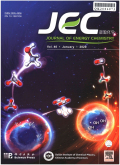- 钛学术文献服务平台 \
- 学术期刊 \
- 工业技术期刊 \
- 石油与天然气工业期刊 \
- 能源化学期刊 \
Functional-selected LiF-intercalated-graphene enabling ultra-stable lithium sulfur battery
Functional-selected LiF-intercalated-graphene enabling ultra-stable lithium sulfur battery
基本信息来源于合作网站,原文需代理用户跳转至来源网站获取
摘要:
Using a functionally selective solid electrolyte interphase (SEI) as an anodic protection layer can effectively avoid the subsequent settlement of uneven lithium electrodeposits for lithium sulfur (Li-S) batteries.To address the issues of single functional,mechanical crushing and peeling of the conventional rigid LiF SEI,a unique functional-selected rigid-flexible-coupled LiF-intercalated-graphene (LiF-GN) SEI as anodic protection is constructed,which is verified by in-operando X-ray photoelectron spectroscopy (XPS) spectra.Owing to the synergistic effect of the LiF and graphene layer,this intercalated functionalselected SEI architecture exhibits a dramatic elastic modulus (rigid-flexible coupling with a shallow Young's modulus (~430 MPa) and a tremendous Young's modulus of~20 GPa),high mechanical strength,and can be repulsive to polysulfides,accompanied unprecedented trafficability of Li ions.Consequently,the forceful exclusion of polysulfides from the LiF-GN SEI,as confirmed by means of in-situ UV/vis analysis,Li2S nucleation tests,and visual permeation experiments,is of profound significance for the effective protection of Li anodes and enables Li-S batteries to achieve remarkable electrochemical performance (ultralow capacity decay rate of 0.022% during 300 cycles at 1 C and high discharge capacity of 1092 mAh/g at 0.5 C).

推荐文章
Ecological stoichiometry of nitrogen, phosphorous, and sulfur in China's forests
Forest
Stoichiometry
Nitrogen
Phosphorous
Sulfur
China
MgH2- graphene复合储氢材料吸放氢性能
储氢材料
MgH2
石墨烯材料
吸放氢性能
Statistics matters in interpretations of non-traditional stable isotopic data
Isotopic data processing
Error propagation
Significant digits
Difference between means with uncertainties
内容分析
关键词云
关键词热度
相关文献总数
(/次)
(/年)
引文网络
引文网络
二级参考文献 (0)
共引文献 (0)
参考文献 (0)
节点文献
引证文献 (0)
同被引文献 (0)
二级引证文献 (0)
2021(0)
- 参考文献(0)
- 二级参考文献(0)
- 引证文献(0)
- 二级引证文献(0)
引文网络交叉学科
相关学者/机构
期刊影响力
能源化学
主办单位:
中国科学院大连化学物理研究所
中国科学院成都有机化学研究所
出版周期:
双月刊
ISSN:
2095-4956
CN:
10-1287/O6
开本:
出版地:
大连市中山路457号
邮发代号:
创刊时间:
语种:
eng
出版文献量(篇)
2804
总下载数(次)
0
期刊文献
相关文献
推荐文献
- 期刊分类
- 期刊(年)
- 期刊(期)
- 期刊推荐
一般工业技术
交通运输
军事科技
冶金工业
动力工程
化学工业
原子能技术
大学学报
建筑科学
无线电电子学与电信技术
机械与仪表工业
水利工程
环境科学与安全科学
电工技术
石油与天然气工业
矿业工程
自动化技术与计算机技术
航空航天
轻工业与手工业
金属学与金属工艺
能源化学2022
能源化学2021
能源化学2020
能源化学2019
能源化学2018
能源化学2017
能源化学2016
能源化学2015
能源化学2014
能源化学2013
能源化学2012
能源化学2011
能源化学2010
能源化学2009
能源化学2008
能源化学2007
能源化学2006
能源化学2005
能源化学2004
能源化学2003
能源化学2002
能源化学2001
能源化学2021年第9期
能源化学2021年第8期
能源化学2021年第7期
能源化学2021年第6期
能源化学2021年第5期
能源化学2021年第4期
能源化学2021年第3期
能源化学2021年第2期
能源化学2021年第12期
能源化学2021年第1期

 免费查重
免费查重










